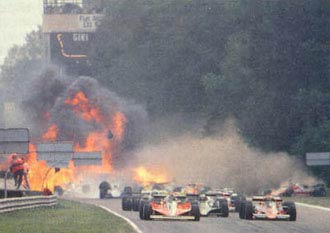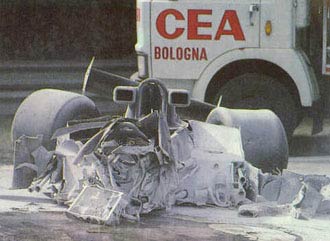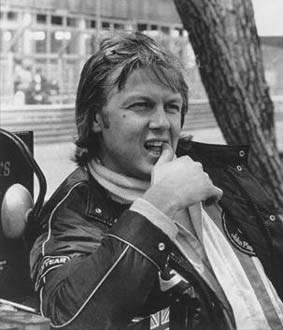It is hard to believe that 22 years have passed since Ronnie Peterson died, following a multi-car pile up at the start of the 1978 Italian Grand Prix. This accident was a milestone in Formula One safety, and despite the tragic loss of one of the greatest drivers of the Seventies, many good things happened in the aftermath of the accident.
 In many ways, Peterson should never have been involved in the accident in the first place. Peterson and his Lotus teammate, Mario Andretti, had dominated the 1978 season in their ground-effects Lotus 79s. Andretti and Peterson had just come from a convincing 1-2 victory at Zandvoort in Holland. At Monza, Andretti took pole in his Lotus 79 while Peterson had had a lot of mechanical problems and qualified the older Lotus 78 in 5th place. By racing the Lotus 78, Peterson was at risk of being caught up in the middle of the pack.
In many ways, Peterson should never have been involved in the accident in the first place. Peterson and his Lotus teammate, Mario Andretti, had dominated the 1978 season in their ground-effects Lotus 79s. Andretti and Peterson had just come from a convincing 1-2 victory at Zandvoort in Holland. At Monza, Andretti took pole in his Lotus 79 while Peterson had had a lot of mechanical problems and qualified the older Lotus 78 in 5th place. By racing the Lotus 78, Peterson was at risk of being caught up in the middle of the pack.
At about three o'clock, 24 cars lined up on the grid, the flag was dropped with some of the cars still rolling into position. On the approach to the Variante Goodyear, Riccardo Patrese's Arrows, which had qualified 12th, touched James Hunt's McLaren, which started from 10th position. The McLaren was spun into Peterson's Lotus and the Lotus was spun into the barriers on the right-hand side of the track, crushing the front of the car. Vittorio Brambilla, who had started from the back of the grid, tried to avoid the accident but his Surtees crashed into Peterson's Lotus. Peterson's Lotus burst into flames. After Niki Lauda's horrific accident two years earlier, there was the sickening thought of "Oh, no not again!"
James Hunt leapt from his McLaren and pulled Peterson from the burning Lotus. Soon the fire was put out and the track officials started to take stock of what had happened: ten cars were involved in the accident, including Brett Lunger, Hans Stuck, who had been concussed, and Didier Pironi. Brambilla had a severe head injury and Peterson had badly broken legs. The Italian Police formed a human wall stopping anyone, including Professor Sid Watkins, the then Surgical Advisor to Formula One, from entering the crash site.
 After a delay of between eleven to eighteen minutes, an ambulance was sent to the accident scene, and Peterson was taken to the Monza medical centre. At the medical centre, Peterson's legs were splinted, IVs were put in, and it was determined that Peterson's burns were not severe. With Peterson's condition stabilised, he was then taken by helicopter to the Ospedale Maggiore at Niguardia, which was about ten minutes away. There, the x-ray exam showed that Peterson had about 27 fractures of his legs and feet. The surgeons decided to pin Peterson's fractured bones when circulation to one of his legs was under threat. The surgeons worked until close to midnight and Peterson was sent to the intensive care unit in stable condition.
After a delay of between eleven to eighteen minutes, an ambulance was sent to the accident scene, and Peterson was taken to the Monza medical centre. At the medical centre, Peterson's legs were splinted, IVs were put in, and it was determined that Peterson's burns were not severe. With Peterson's condition stabilised, he was then taken by helicopter to the Ospedale Maggiore at Niguardia, which was about ten minutes away. There, the x-ray exam showed that Peterson had about 27 fractures of his legs and feet. The surgeons decided to pin Peterson's fractured bones when circulation to one of his legs was under threat. The surgeons worked until close to midnight and Peterson was sent to the intensive care unit in stable condition.
At close to four o'clock in the morning, Professor Watkins received a call informing him that Peterson's condition had worsened. By the time he reached the hospital, Peterson was clinically brain-dead: he had died from a fat embolism - a fairly rare condition that can follow fractures of the thigh. In layman's terms, fat deposits form in the blood vessels of the patient, which, in Peterson's case, blocked circulation through the lungs and starved his brain of oxygen. Even today, there is little that can be done after a fat embolism forms, and the risk of an embolism forming is higher the longer the patient is left untreated and the longer and more complicated the surgery.
Clearly there needed to be better organisation of medical treatment at the circuits. Professor Watkins and the Formula One Constructors Association (FOCA) chief Bernie Ecclestone, with the support of Niki Lauda and Jackie Stewart, concluded that a medical car should follow the Formula One cars on the first lap so that injured drivers could receive almost immediate medical help. This came to pass at the 1978 US Grand Prix at Watkins Glen. Fast-forward to 1999 and we witnessed the impressive speed that Michael Schumacher received medical treatment at Silverstone.
 It was also clear that expert firemen should be putting out fires quickly instead of drivers having to pull their fellow drivers from burning wrecks. Fast-forward to 1989, when Gerhard Berger's Ferrari caught fire after a crash at the Tamburello of Imola: Constructione Estintori Automatica fire marshals quickly put out the fire and Berger was safely removed by fire marshalls and medical staff.
It was also clear that expert firemen should be putting out fires quickly instead of drivers having to pull their fellow drivers from burning wrecks. Fast-forward to 1989, when Gerhard Berger's Ferrari caught fire after a crash at the Tamburello of Imola: Constructione Estintori Automatica fire marshals quickly put out the fire and Berger was safely removed by fire marshalls and medical staff.
Furthermore, it was obvious that there were specific problems with Monza that led to the accident in the first place. FOCA exerted pressure on the Monza authorities to make the circuit safer, and as a first step, barriers were moved back and the pit area was redesigned. Slowly Monza evolved into a less dangerous circuit.
It has also been a long road to improve the safety of Formula One cars. Open-wheeled Lotuses designed by Colin Chapman were notoriously flimsy and lacking in features for protecting a driver in the event of a severe crash. Fast-forward to 2000: during last week's testing at Monza, both Jos Verstappen and Giancarlo Fisichella had accidents that could have been as severe as Peterson's, had they been driving 1978-specification Formula One cars.
The most unfortunate consequence of the accident was that Riccardo Patrese was blamed for the accident by his fellow drivers and was banned from the US Grand Prix. Subsequent investigations cleared Patrese, and thankfully, this form of "instant justice" has never been repeated in Formula One.
Would Peterson have survived if the same accident had happened today in the same car? Perhaps. Martin Donnelly survived from similar injuries at Jerez in 1990, for example; after a collision with a barrier, Donnelly's Lotus split open tossing him onto the track. Like Peterson, Donnelly had severely broken legs but he was also unconscious. Donnelly was treated quickly on the track, rapidly taken to the Jerez medical centre, his fractures were efficiently stabilised and he was promptly flown to a trauma centre in Seville. Donnelly had a long road to recovery but he avoided having a lethal embolism like Peterson.
When famous people die at an early age sometime the public has difficulty accepting this. There have even been outlandish claims that, like Elvis Presley and Jim Morrison, Peterson faked his own death and is living in seclusion. If only that were true...
Editorial Note: The article relies on research made by the author on the subject and on public records. Special acknowledgement goes to Professor Sid Watkins' account in his autobiography, "Life at the Limit"

